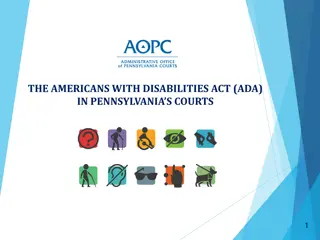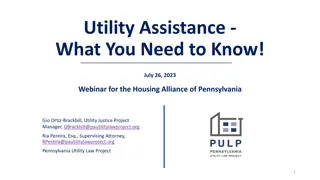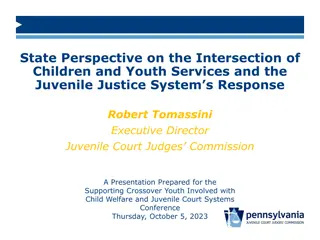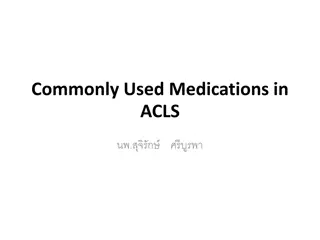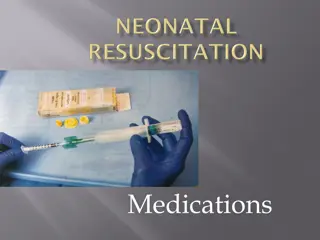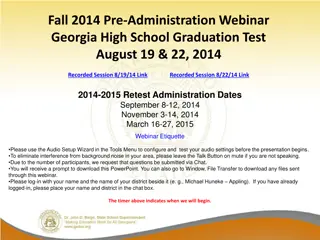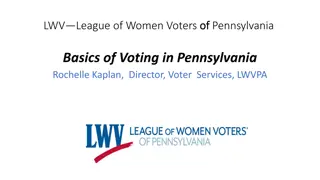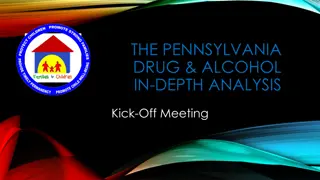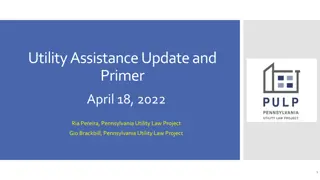Syringe-Based EPINEPHrine Administration Education in Pennsylvania
The Pennsylvania Emergency Health Services Council is promoting syringe-based EPINEPHrine administration for EMTs as a cost-effective and safe alternative to auto-injectors. This initiative aims to educate on anaphylaxis pathophysiology, EPINEPHrine pharmacology, and safe medication practices while demonstrating proper administration procedures. By utilizing syringes, significant cost savings can be achieved without compromising quality care. Several states have already implemented similar programs with positive outcomes.
Download Presentation

Please find below an Image/Link to download the presentation.
The content on the website is provided AS IS for your information and personal use only. It may not be sold, licensed, or shared on other websites without obtaining consent from the author.If you encounter any issues during the download, it is possible that the publisher has removed the file from their server.
You are allowed to download the files provided on this website for personal or commercial use, subject to the condition that they are used lawfully. All files are the property of their respective owners.
The content on the website is provided AS IS for your information and personal use only. It may not be sold, licensed, or shared on other websites without obtaining consent from the author.
E N D
Presentation Transcript
Syringe-Based EPINEPHrine Administration: Education for Pennsylvania EMTs Pennsylvania Emergency Health Services Council
The Pennsylvania Emergency Health Services Council serves as the advisory board to the Pennsylvania Department of Health on all matters related to emergency medical services. The administration of EPINEPHrine using an alternative device to the traditional auto-injector is an initiative by the Council s statewide medical advisory committee, which is comprised primarily of the regional medical director and approved by the board of directors. The education program that follows was designed with the input and review of the statewide medical advisory committee and other stakeholders. It is the first of a two-part education process, which will conclude with a practical skills lab conducted by the agency medical director. Pennsylvania Emergency Health Services Council
Course Objectives Provide a rationale for syringe-based EPINEPHrine administration vs. auto injector Review anaphylaxis pathophysiology Review basic EPINEPHrine pharmacology Review safe medication administration practices Demonstrate medication administration procedure Pennsylvania Emergency Health Services Council
Why Syringe-Based EPINEPHrine? Rising cost of auto-injector devices $400 to $600 per vehicle 2-year expiration date and low frequency of use With appropriate education, EMTs can safely administer EPINEPHrine using a dose-limited syringe Significant savings at both EMS agency and system level Pennsylvania Emergency Health Services Council
History of Syringe EPINEPHrine Kits King County, Washington (2014) 3500 EMTs trained No injuries to providers No reported medication administration errors or bad patient outcomes First year system savings estimated to be $150,000 Other states with similar programs include: New York, West Virginia, Florida, Alaska and Montana Pennsylvania Emergency Health Services Council
Anaphylaxis Overview A serious and systemic allergic reaction Multi-system involvement Rapid onset Upper airway swelling Respiratory distress symptoms Shock If left untreated, anaphylaxis can cause DEATH! Pennsylvania Emergency Health Services Council
Anaphylaxis is NOT An insect bite with localized swelling and itching A runny nose Sneezing Watery eyes Hives/Rash without respiratory distress Pennsylvania Emergency Health Services Council
Common Causes of Anaphylaxis Foods Nuts Shellfish Fruits Insects Bees Spiders Medications/Latex Antibiotics Pennsylvania Emergency Health Services Council
Signs & Symptoms Respiratory distress and wheezing or stridor Swollen tongue and/or lips Difficulty swallowing Hypotension Tachycardia Extensive hives with itching Pennsylvania Emergency Health Services Council
Case Study 1 35 yo male was working in his garden when stung by a bee Experienced pain, swelling and itching at the sting site and is concerned he is having an allergic reaction No known allergy to bee stings No of shortness of breath w/ clear lungs fields Visible hives Appears very anxious Vital signs on EMS arrival: HR 90 RR 24 BP 122/80 SPO2 98% on room air Pennsylvania Emergency Health Services Council
Case Study 2 15 yo male at summer camp when stung by a bee Presents to camp nurse 30 minutes later Patient has known allergy to bee stings Painful swelling at sting site Complains of shortness of breath with audible wheezing Nurse administered patient prescribed epi auto-injector before calling 911 Vital signs on EMS arrival: HR 96 RR 24 BP 132/64 SPO2 96% - lungs now clear Pennsylvania Emergency Health Services Council
Case Study 3 79-year-old female with allergy to shellfish Taken out to dinner no known exposure Developed hives over face, chest and back Took OTC Benadryl EMS called after patient started to experience dyspnea Vital signs on EMS arrival: HR 106 RR 36 BP 102/52 SPO2 88% with shallow respirations and audible wheezes Pennsylvania Emergency Health Services Council
Case Study 4 3-year-old female felt sick after eating strawberries at a picnic Rash noted around mouth Over the next 15 minutes, patient becomes pale and has < LOC; only responds to painful stimuli Vital signs on EMS arrival: HR: 120 RR: 10 BP: capillary refill >4 sec SPO2: 85% with almost barely audible breath sounds and wheezes noted Pennsylvania Emergency Health Services Council
Treatment Dispatch ALS if not responding (Protocol 210) Perform assessment (Protocol 201) Monitor SPO2 (Protocol 226) Administer oxygen if SPO2 <95% (Protocol 202) If anaphylaxis suspected, administer EPINEPHrine using 1mg/ml concentration (Protocol 411) Adult Dose 0.3 mg (0.3ml) IM Pediatric Dose 0.15 mg* (0.15ml) IM *A pediatric patient is defined as a child < 8 y.o. or < 55lbs (25 kg) body weight Pennsylvania Emergency Health Services Council
PA BLS Protocol 411 Pennsylvania Emergency Health Services Council
PA BLS Protocol 411 Pennsylvania Emergency Health Services Council
EPINEPHrine Synthetic version of naturally occurring adrenalin Dilates bronchioles to ease breathing Increases heart rate and strength of contractions Increases blood pressure Note: Due to the cardiovascular effects of epinephrine, consider medical command Note: Due to the cardiovascular effects of epinephrine, consider medical command consult before administering to a patient with a history of cardiovascular consult before administering to a patient with a history of cardiovascular disease or 55 disease or 55 y.o y.o. . Pennsylvania Emergency Health Services Council
EPINEPHrine Onset of action Typically, 90 seconds in a healthy patient In anaphylaxis, may take 3-5 minutes If no change after 5 minutes, contact medical command for possible 2nddose Duration of action Typically, 1-4 hours Possible side effects Palpitations Anxiousness and/or Tremors Headache Pennsylvania Emergency Health Services Council
Medication Administration Pennsylvania Emergency Health Services Council
Medication Administration 1. VERIFY MEDICATION EPINEPHrine 1mg in 1 ml container Expiration Date Contents of vial should be clear Pennsylvania Emergency Health Services Council
Medication Administration A dose-limiting syringe that is specifically marked for adult or peds epinephrine is required for this method of administration. Pre-packaged kits are also available which contain the medication, special syringe and other ancillary supplies. Peds Adult Pennsylvania Emergency Health Services Council
Medication Administration 2. DRAW UP EPINEPHRINE WITH A 1ML SYRINGE Remove protective cap from the vial, clean rubber stopper with alcohol pad Place vial on flat surface Instill air in the vial equal to amount of fluid to be removed With the needle still in vial, invert both syringe and vial together Withdraw desired amount of medication Expel any bubble and excess liquid To ensure penetration of the muscle, use a a needle that is 1-1 inches in length Pennsylvania Emergency Health Services Council
Medication Administration Using Dose-Limiting Syringe 3. VERIFY DOSAGE ADULT: PEDIATRIC: 0.15 mg (0.15ml) 0.3 mg (0.3ml) 0.15ml (Half of Adult Dose: for children < 8 yo or < 55lbs/25kg) 0.3ml Pennsylvania Emergency Health Services Council
Medication Administration Pennsylvania Emergency Health Services Council
Medication Administration If epi is supplied in a glass ampule, caution must be used when detaching the top of the container to avoid injury from sharp or jagged glass. A filter straw (below) or filter needle should be used to withdraw the medication first, then switch to an appropriate size hypodermic needle for administration. A barrier, such as an alcohol prep pad or gauze sponge should be used when detaching the ampule s top. The filter device will capture any glass fragments that may fall into the ampule when the top is detached. Ampules are not recommended for BLS providers. Pennsylvania Emergency Health Services Council
Medication Administration Pennsylvania Emergency Health Services Council
Medication Administration Pediatrics (preteen/teenager) Adults 4. SELECT INJECTION SITE Deltoid Pennsylvania Emergency Health Services Council
Medication Administration Pediatrics (infant/toddler) Adults Adults w/ little arm muscle Vastus Lateralis (Lateral Thigh) Pennsylvania Emergency Health Services Council
Medication Administration 5. INJECT To ensure penetration of the muscle, use a needle 1-1 inches in length Cleanse injection site with an alcohol prep pad using circular motion working from center outward Stretch the skin taut over inject site and insert needle at 90o angle Pull back on plunger to aspirate for blood. If blood is noted in syringe barrel, withdraw needle and prepare a new syringe and different injection site If no blood, inject medication; when complete withdraw needle and dispose of syringe in sharps container Pennsylvania Emergency Health Services Council
Medication Administration 6. DOCUMENT Time Medication Name EPINEPHrine Concentration 1mg/ml Amount Administered 0.3mg or 0.15mg Injection Site L/R Deltoid or Lateral Thigh Patient response to medication Pennsylvania Emergency Health Services Council
Medication Administration 7. MONITOR PATIENT Anticipated response to medication Common side effects Anxiousness Tremors Increases heart rate or palpitations Headache Vital Signs, SPO2 and lung sounds If no improvement after 5 minutes and ALS not yet on scene contact medical command to discuss repeat dose of epinephrine Pennsylvania Emergency Health Services Council
Review Anaphylaxis is a serious and systemic reaction Rapid recognition and treatment is essential Symptoms may include difficultly breathing, facial/airway swelling and shock EPINEPHrine, a synthetic version of adrenalin, is the drug of choice in anaphylaxis EPINEPHrine administered by a special dose- limiting syringe is an economical alternative to an auto-injector Pennsylvania Emergency Health Services Council
References 1. Husain S, Nolan J, Latimer A, Eisenberg M, (2017, June) EPINEPHrine Economics. Journal of Emergency Medical Services 27-30. Caroline N, (2013) Emergency Care in the Streets 511-520 Burlington: Jones Bartlett 2023 Pennsylvania Statewide Basic Life Support Protocols 2023 Pennsylvania Statewide Advanced Life Support Protocols New York State Check and Inject EMT EPINEPHrine Program West Virginia EMT EPINEPHrine Training Module 2. 3. 4. 5. 6. Pennsylvania Emergency Health Services Council
Proceed to Skills Verification with Medical Director Pennsylvania Emergency Health Services Council




